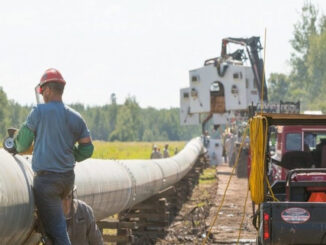
In the heart of America’s energy landscape, the Permian Basin continues to drive record levels of natural gas production, often as a byproduct of oil extraction. However, with growing demand for natural gas in Texas—fueled by surging electricity needs and expanding liquefied natural gas (LNG) exports—a new infrastructure project is stepping up to bridge the gap. The Eiger Express Pipeline, a collaborative effort by leading midstream companies, promises to enhance gas takeaway capacity from the Permian Basin to key demand centers along the U.S. Gulf Coast. This initiative not only aims to reduce flaring and stabilize prices but also underscores the industry’s commitment to meeting escalating energy requirements.
Are you Paying High Taxes in New Jersey, New York, or California?
Project Overview and Planned Gas Takeaway
The Eiger Express Pipeline is designed as a 450-mile, 42-inch diameter conduit capable of transporting up to 2.5 billion cubic feet per day (Bcf/d) of natural gas.
Originating from the Midland and Delaware basins in West Texas, the pipeline will route eastward to the Katy area near Houston, with reserved capacity extending deliveries to Corpus Christi. This strategic path targets high-demand markets, alleviating bottlenecks in the Permian where excess gas has historically led to constrained pricing and environmental concerns like flaring.The project’s gas takeaway plan is particularly timely. Permian Basin production has been on an upward trajectory, with natural gas output often exceeding existing pipeline capacities. By adding 2.5 Bcf/d of transport capability, Eiger Express will help evacuate surplus volumes, supporting broader U.S. energy security and export ambitions. The pipeline builds on the existing Matterhorn joint venture infrastructure, ensuring efficient integration into the regional network.
Potential Customers and Market Drivers
While specific customer names have not been publicly disclosed, the pipeline is backed by firm transportation agreements spanning 10 years or longer, signaling robust commitments from downstream users.
Potential customers are likely to include power generators, industrial users, and LNG export facilities along the Gulf Coast. Texas’s electricity demand has surged due to population growth, data centers, and electrification trends, while international LNG demand—particularly from Europe and Asia—continues to rise amid global energy transitions.
Entities in the electricity sector, such as utilities and independent power producers, could benefit from reliable, low-cost Permian gas supplies. Similarly, LNG exporters in the Corpus Christi and Houston areas stand to gain from enhanced feedstock availability, potentially boosting U.S. export volumes. This aligns with industry forecasts predicting sustained Permian growth, making Eiger Express a critical link in the supply chain.
Pipeline Operators and Construction Companies
The Eiger Express is a joint venture involving ONEOK, Inc., MPLX LP, WhiteWater Midstream, and Enbridge Inc., leveraging the established Matterhorn JV framework with additional direct stakes from ONEOK and MPLX.
WhiteWater Midstream will take the lead on both construction and operations, drawing on its expertise in Permian infrastructure. The project is slated for completion by mid-2028, subject to customary regulatory approvals from bodies like the Federal Energy Regulatory Commission (FERC).WhiteWater’s role highlights its growing prominence in midstream development, with a track record of building pipelines that connect production hubs to markets. No additional construction firms have been named, suggesting WhiteWater may handle much of the buildout in-house or through established subcontractors. This collaborative model among operators ensures shared risks and resources, a common strategy in large-scale energy projects.
Investment Landscape and Potential Investors
The Eiger Express Pipeline is underpinned by strong financial backing from its partner companies, each of which attracts significant institutional investment. Understanding the investor base of these entities provides insight into the project’s stability and appeal to capital markets.ONEOK, Inc.: As a key participant, ONEOK benefits from major shareholders like Vanguard Group Inc. (holding approximately 76.51 million shares, or 12.15% as of mid-2025), BlackRock Inc. (56.56 million shares, 8.98%), and Geode Capital Management LLC (15.8 million shares).
Other notable investors include Morgan Stanley (11.27 million shares) and Invesco Ltd. (8.39 million shares).
These institutional giants reflect confidence in ONEOK’s midstream operations and growth potential.
Enbridge Inc.: Enbridge’s involvement draws from its vast pipeline portfolio, supported by investors such as BMO Asset Management Corp. (about 55.18 million shares, 2.53%), RBC Global Asset Management Inc. (51.5 million shares, 2.36%), Goldman Sachs Group Inc. (41.52 million shares), and TD Asset Management Inc. (39.88 million shares).
Institutional ownership has seen a slight uptick to around 50.65% in early 2025, indicating steady interest in Enbridge’s diversified energy assets.
MPLX LP: Dominated by its parent company, Marathon Petroleum Corp. (647.42 million shares, 63.53%), MPLX also counts Alps Advisors Inc. (26.08 million shares), Invesco Ltd. (19.42 million shares), and Blackstone Inc. (16.94 million shares) among its top holders.
This structure provides MPLX with substantial backing for logistics and transportation ventures like Eiger Express.
WhiteWater Midstream: As a private entity, WhiteWater is partnered with private equity funds including Ridgemont Equity Partners, Denham Capital Management, First Infrastructure Capital, and Trace Capital Management.
These investors focus on infrastructure development, enabling WhiteWater’s rapid expansion in the Permian since its founding in 2016.
This investor ecosystem—comprising pension funds, asset managers, and private equity—highlights the project’s attractiveness amid rising energy demands. Potential new investors may be drawn by the long-term contracts and strategic positioning, further solidifying the pipeline’s role in Texas’s energy future.
Broader Implications
The Eiger Express Pipeline represents a proactive response to Texas’s evolving energy needs, potentially curbing gas waste and supporting economic growth. As the state grapples with grid reliability and export ambitions, projects like this could pave the way for a more resilient infrastructure. However, challenges such as regulatory hurdles and environmental scrutiny remain. Stakeholders will watch closely as construction progresses toward the 2028 target, marking another milestone in America’s energy independence.
Avoid Paying Taxes in 2025
Crude Oil, LNG, Jet Fuel price quote
ENB Top News
ENB
Energy Dashboard
ENB Podcast
ENB Substack






